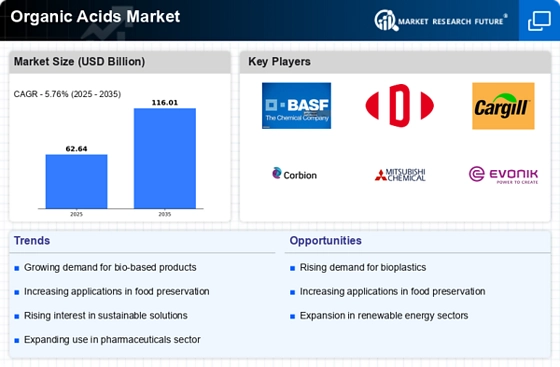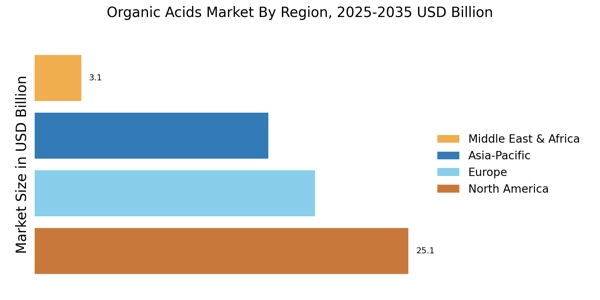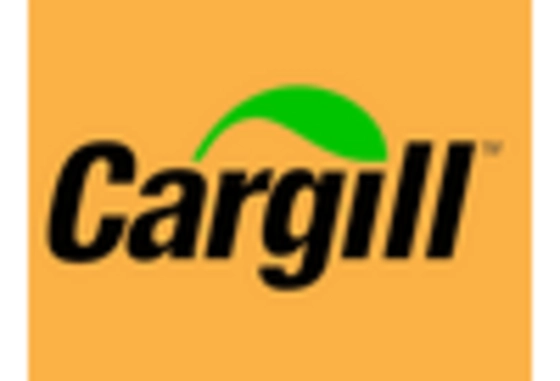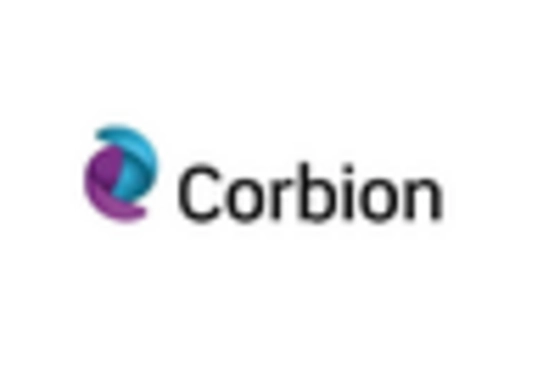Expanding Use in Agriculture
The agricultural sector is increasingly adopting organic acids as natural fertilizers and soil conditioners, which is driving growth in the Organic Acids Market. Organic acids, such as humic acid and fulvic acid, are recognized for their ability to enhance soil health and improve nutrient uptake in plants. This trend is particularly relevant as the demand for sustainable agricultural practices continues to rise. Recent studies indicate that the use of organic acids in agriculture can lead to yield increases of up to 20%, making them an attractive option for farmers. As the agricultural sector seeks to improve productivity while minimizing environmental impact, the Organic Acids Market is poised for expansion, reflecting the growing integration of organic acids into modern farming practices.
Growth in Food and Beverage Sector
The food and beverage sector is a significant driver for the Organic Acids Market, as these compounds are widely used as preservatives, flavoring agents, and acidulants. The increasing consumption of processed and convenience foods has led to a heightened demand for organic acids, particularly citric acid and acetic acid. Market data suggests that the food and beverage segment accounts for nearly 60% of the total organic acids consumption, reflecting its critical role in the industry. Additionally, the trend towards healthier eating habits has prompted manufacturers to incorporate organic acids as natural preservatives, further boosting their usage. This growth trajectory indicates that the Organic Acids Market is likely to expand in tandem with the evolving dynamics of the food and beverage landscape.
Rising Applications in Pharmaceuticals
The pharmaceutical industry is increasingly recognizing the value of organic acids, which are utilized in drug formulation and as intermediates in the production of active pharmaceutical ingredients. The Organic Acids Market is experiencing growth due to the rising demand for organic acids in pharmaceutical applications, particularly for compounds like citric acid and ascorbic acid. These acids serve essential roles in enhancing drug stability and bioavailability. Recent market analysis indicates that the pharmaceutical segment is expected to witness a growth rate of approximately 8% annually, driven by the ongoing advancements in drug development and the increasing prevalence of chronic diseases. This trend suggests a promising outlook for the Organic Acids Market as it aligns with the expanding pharmaceutical sector.
Increasing Demand for Biodegradable Products
The rising consumer preference for environmentally friendly products is driving the Organic Acids Market. As sustainability becomes a priority, industries are increasingly seeking biodegradable alternatives to synthetic chemicals. Organic acids, such as citric acid and lactic acid, are gaining traction due to their natural origins and minimal environmental impact. This shift is evident in sectors like food and beverages, where organic acids serve as preservatives and flavor enhancers. According to recent data, the demand for biodegradable products is projected to grow at a compound annual growth rate of over 10% in the coming years, indicating a robust market potential for organic acids. The Organic Acids Market is thus positioned to benefit from this trend, as manufacturers adapt to meet the evolving preferences of eco-conscious consumers.
Technological Advancements in Production Processes
Technological innovations in the production of organic acids are significantly influencing the Organic Acids Market. Advances in fermentation technology and bioprocessing techniques have enhanced the efficiency and yield of organic acid production. For instance, the use of genetically modified microorganisms has been shown to increase the production rates of lactic acid and succinic acid. This not only reduces production costs but also meets the growing demand for high-purity organic acids. Market data indicates that the adoption of these technologies could potentially increase the overall production capacity of organic acids by 15% over the next few years. Consequently, the Organic Acids Market is likely to benefit from these advancements, as manufacturers strive to optimize their processes and meet the rising demand.


















Leave a Comment